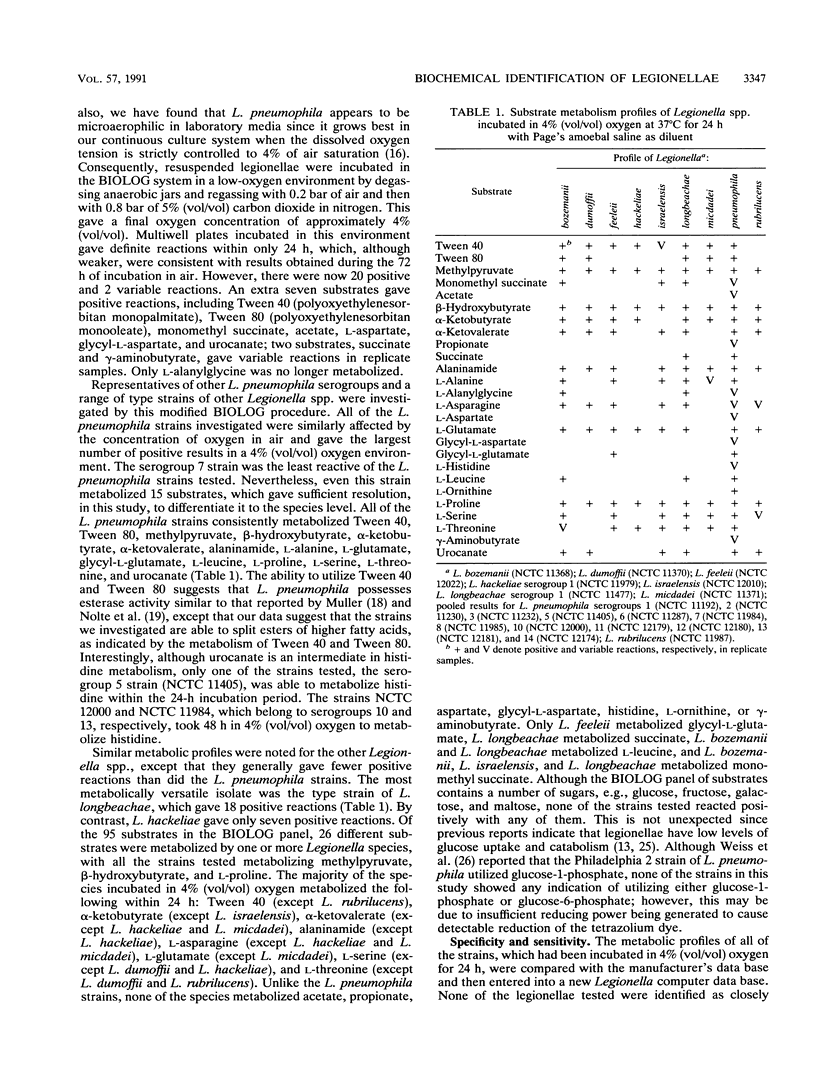Abstract
The genus Legionella consists of 51 serogroups comprising 34 species. Biochemical reactions and cell wall fatty acid and quinone analyses may confirm that an isolate is a Legionella sp. and indicate to which species it belongs, but DNA hybridization studies have been necessary for a definitive identification. Recently, the commercially available BIOLOG identification system has offered a standardized, easily reproducible system of substrate metabolism by bacteria resuspended in multiwell plates. A tetrazolium dye acts as an electron acceptor during the oxidation of the wide range of substrates and forms an irreversible, highly colored formazan when reduced. The 95 substrate wells are read rapidly with a conventional plate reader, and the results are downloaded for comparison with a computer data base, allowing quick identification. The BIOLOG system's ability to test more diverse classes of substrates, including amino acids, peptides, carboxylic acids, and carbohydrates, was used in this study to establish a new data base and identify the asaccharolytic Legionella spp. In particular, Legionella pneumophila behaved as a microaerophile, and the fastest, most diverse metabolic activities occurred after the development of a low-oxygen incubation environment. Alternatively, bacteria could be successfully incubated in air when their concentration was double that recommended by the manufacturer. Similar results were obtained by using either Page's amoebal saline or distilled water as the resuspending and incubation medium. Type strains did not cross-identify with any of the strains already in the manufacturer's data base. The results indicate that this modified system has value in being able to identify Legionella isolates to the species level.
Full text
PDF




Selected References
These references are in PubMed. This may not be the complete list of references from this article.
- Brenner D. J. Classification of Legionellaceae. Current status and remaining questions. Isr J Med Sci. 1986 Sep;22(9):620–632. [PubMed] [Google Scholar]
- Brenner D. J., Steigerwalt A. G., McDade J. E. Classification of the Legionnaires' disease bacterium: Legionella pneumophila, genus novum, species nova, of the family Legionellaceae, familia nova. Ann Intern Med. 1979 Apr;90(4):656–658. doi: 10.7326/0003-4819-90-4-656. [DOI] [PubMed] [Google Scholar]
- Chandler F. W., Blackmon J. A., Hicklin M. D., Cole R. M., Callaway C. S. Ultrastructure of the agent of Legionnaires' disease in the human lung. Am J Clin Pathol. 1979 Jan;71(1):43–50. doi: 10.1093/ajcp/71.1.43. [DOI] [PubMed] [Google Scholar]
- Fraser D. W., Tsai T. R., Orenstein W., Parkin W. E., Beecham H. J., Sharrar R. G., Harris J., Mallison G. F., Martin S. M., McDade J. E. Legionnaires' disease: description of an epidemic of pneumonia. N Engl J Med. 1977 Dec 1;297(22):1189–1197. doi: 10.1056/NEJM197712012972201. [DOI] [PubMed] [Google Scholar]
- Hoffman P. S., Pine L., Bell S. Production of superoxide and hydrogen peroxide in medium used to culture Legionella pneumophila: catalytic decomposition by charcoal. Appl Environ Microbiol. 1983 Mar;45(3):784–791. doi: 10.1128/aem.45.3.784-791.1983. [DOI] [PMC free article] [PubMed] [Google Scholar]
- Locksley R. M., Jacobs R. F., Wilson C. B., Weaver W. M., Klebanoff S. J. Susceptibility of Legionella pneumophila to oxygen-dependent microbicidal systems. J Immunol. 1982 Nov;129(5):2192–2197. [PubMed] [Google Scholar]
- Müller H. E. Enzymatic profile of Legionella pneumophilia. J Clin Microbiol. 1981 Mar;13(3):423–426. doi: 10.1128/jcm.13.3.423-426.1981. [DOI] [PMC free article] [PubMed] [Google Scholar]
- Nolte F. S., Hollick G. E., Robertson R. G. Enzymatic activities of Legionella pneumophila and Legionella-like organisms. J Clin Microbiol. 1982 Jan;15(1):175–177. doi: 10.1128/jcm.15.1.175-177.1982. [DOI] [PMC free article] [PubMed] [Google Scholar]
- Page F. C. Taxonomic criteria for limax amoebae, with descriptions of 3 new species of Hartmannella and 3 of Vahlkampfia. J Protozool. 1967 Aug;14(3):499–521. doi: 10.1111/j.1550-7408.1967.tb02036.x. [DOI] [PubMed] [Google Scholar]
- Pasculle A. W., Feeley J. C., Gibson R. J., Cordes L. G., Myerowitz R. L., Patton C. M., Gorman G. W., Carmack C. L., Ezzell J. W., Dowling J. N. Pittsburgh pneumonia agent: direct isolation from human lung tissue. J Infect Dis. 1980 Jun;141(6):727–732. doi: 10.1093/infdis/141.6.727. [DOI] [PubMed] [Google Scholar]
- Pine L., George J. R., Reeves M. W., Harrell W. K. Development of a chemically defined liquid medium for growth of Legionella pneumophila. J Clin Microbiol. 1979 May;9(5):615–626. doi: 10.1128/jcm.9.5.615-626.1979. [DOI] [PMC free article] [PubMed] [Google Scholar]
- Rodgers F. G., Davey M. R. Ultrastructure of the cell envelope layers and surface details of Legionella pneumophila. J Gen Microbiol. 1982 Jul;128(7):1547–1557. doi: 10.1099/00221287-128-7-1547. [DOI] [PubMed] [Google Scholar]
- Tesh M. J., Morse S. A., Miller R. D. Intermediary metabolism in Legionella pneumophila: utilization of amino acids and other compounds as energy sources. J Bacteriol. 1983 Jun;154(3):1104–1109. doi: 10.1128/jb.154.3.1104-1109.1983. [DOI] [PMC free article] [PubMed] [Google Scholar]


